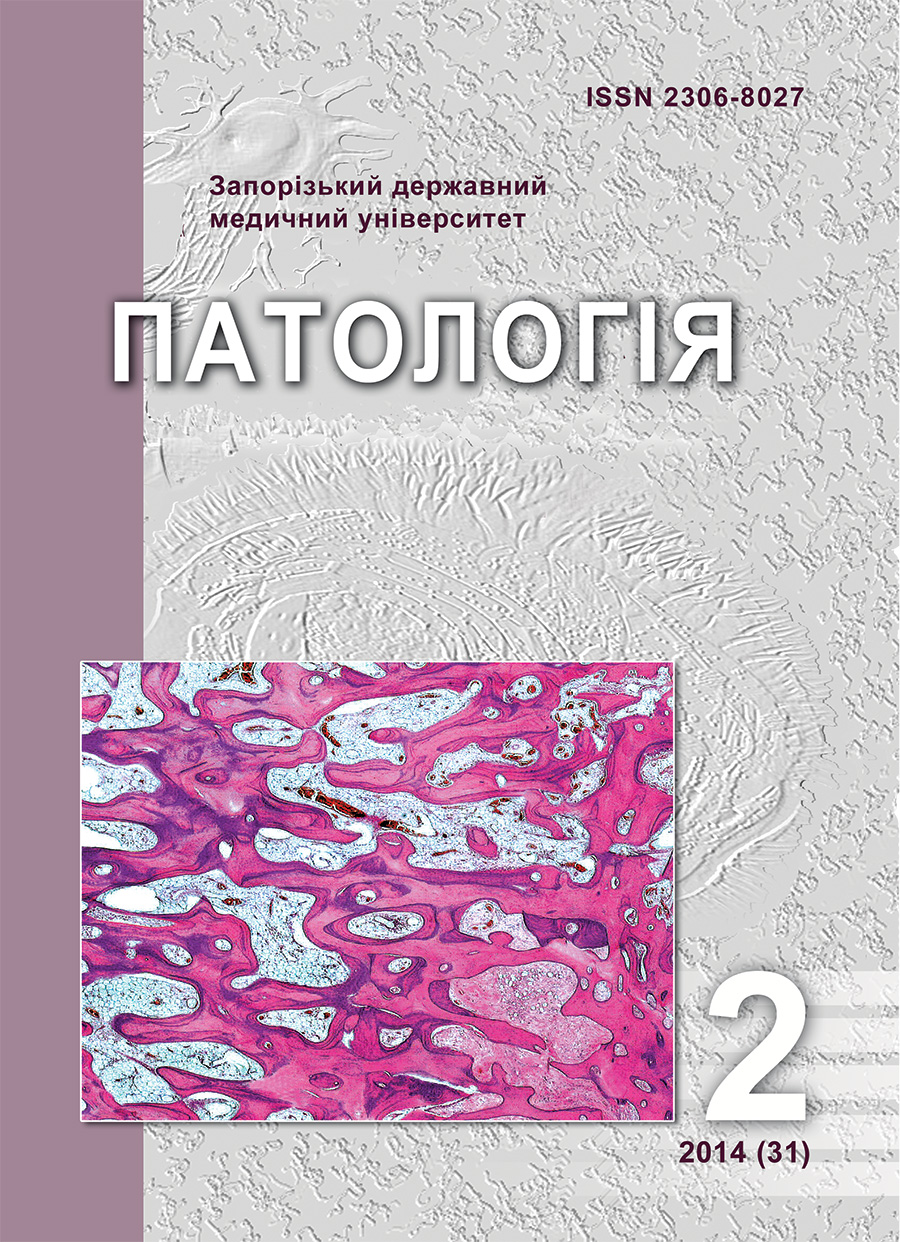Immunohistochemical properties of the expression of endothelial nitric oxide synthase in placenta in its dysfunction in women with iron deficiency anemia
DOI:
https://doi.org/10.14739/2310-1237.2014.2.28562Keywords:
Endothelial Nitric Oxide Synthase, Placental Insufficiency, Iron-Deficiency Anemia, PregnancyAbstract
Aim. The pertinence of the study is related to a large prevalence of dysfunction of the placenta in pregnant women suffering from anemia. To evaluate the immunohistochemical expression characteristics of endothelial NO-synthase (eNOS) in the placenta during its dysfunction in women against the background of anemia 30 samples of placental tissue were studied with the use of immunohistochemical and micrometer methods.
Mеthods and results. It was found that the expression of eNOS in patients with iron deficiency anemia in the cytoplasm of syncytium of villi and fetal capillary endothelium as well as decidual vessels decreases, with the most pronounced changes in the expression of eNOS observed in the presence of the combination of placental dysfunction and iron deficiency anemia in the form of paradoxical increase in expression.
Conclusion. This indicates the necessity for correction of endothelial function in women with anemia during pregnancy.
References
Radomski, M. W., & Moncada, S. (1993) Regulation of vascular homeostasis by nitric oxide. ThrombHaemost, 70(1), 36–41.
Leak, L. V., Cadet, J. L., Griffin, C. P., Richardson, K. (1995) Nitric oxide production by lymphatic endothelial cells in vitro. Biochem Biophys Res Commun., 217(1), 96–105. doi: 10.1006/bbrc.1995.2750.
Jones, T. C., & Hingorani, A. D.(2005) Genetic regulation of endothelial function. Heart, 91, 1275–1277.
Kusinski, L. C., Stanley, J. L., Dilworth, M. R., Hirt, C. J., Andersson, I. J., Renshall, L. J., et al. (2012) eNOS knockout mouse as a model of fetal growth restriction with an impaired uterine artery function and placental transport phenotype. Am J Physiol Regul Integr Comp Physiol., 303(1), R86-93.
Pokrovskij, M. V., Pokrovskaya, T. G., Gureev, V. V., Barsuk, A. A. , Proskuryakova, E. V., Korokin, M. V., et al. (2012) Ispol'zovanie l-arginina v korrekcii e`ndotelial'noj disfunkcii pri e`ksperimental'noj pree`klampsii [Correction of endothelial dysfunction by L-Arginine under Experimental Pre-Eclampsia Conditions]. E`ksperimental'naya i klinicheskaya farmakologiya, 75(2), 14–16. [inRussian].
Burlev, V. A., Zajdieva, Z. S., Tyutyunnik, V. L. (2011) Kliniko-diagnosticheskoe znachenie opredeleniya faktora rosta placenty u beremennykh [Clinical disgnostic value of the determination of placentary growth factor amongst pregnant females]. Problemy reprodukcii, 5, 1–6. [in Russian].
Larina, E. B., Mamedov, N. N., Nefedova, N. A., Moskvina, L. V., Andreev, A. I., Panina, O. B., Mal’kov, P. G. (2013) Sindrom zaderzhki rosta ploda: kliniko-morfologicheskie aspekty [Fetal growth retardation syndrome: clinical-morphological aspects]. Voprosy ginekologii, akusherstva i perinatologii, 1(12), 22–27. [in Russian].
Abe, H., Ishikawa, W., Kushima, T., Nishimura, T., Mori, C., Onuki, A., et al. (2013). Nitric oxide induces vascular endothelial growth factor expression in the rat placenta in vivo and in vitro. BiosciBiotechnolBiochem, 77(5), 971–976.
Orange, S. J., Painter, D., Horvath, J., Yu, B., Trent, R., Hennessy, A. (2003) Placental endothelial nitric oxide synthase localization and expression in normal human pregnancy and pre-eclampsia. Clin Exp Pharmacol Physiol, 30(5–6), 376–381.
Downloads
How to Cite
Issue
Section
License
Authors who publish with this journal agree to the following terms:- Authors retain copyright and grant the journal right of first publication with the work simultaneously licensed under a Creative Commons Attribution License that allows others to share the work with an acknowledgement of the work's authorship and initial publication in this journal.

- Authors are able to enter into separate, additional contractual arrangements for the non-exclusive distribution of the journal's published version of the work (e.g., post it to an institutional repository or publish it in a book), with an acknowledgement of its initial publication in this journal.
- Authors are permitted and encouraged to post their work online (e.g., in institutional repositories or on their website) prior to and during the submission process, as it can lead to productive exchanges, as well as earlier and greater citation of published work (SeeThe Effect of Open Access).

